by
<a href="mailto:communicationsteam@awcnet.org">Communications</a> | Dec 11, 2023
The City of Medical Lake models response, recovery, and resilience in the aftermath of a natural disaster.
The City of Medical Lake models response, recovery, and resilience in the aftermath of a natural disaster.
By: Sarah Chase Shaw
On Tuesday, August 15, 2023, the City of Medical Lake Fire Chief Cody Rohrbach of Spokane County District 3 issued a dire warning to the city council: “Friday, August 18, is going to be the worst fire weather of the year.”
Around noon on that Friday, Rohrbach received reports of a brush fire burning in 1 or two acres of wheat field off Gray Road about 5 miles southwest of Medical Lake—a community of 5,000 less than 20 miles southwest of Spokane. Within minutes, fueled by sustained high winds, the brush fire exploded into a runaway conflagration, burning through southside neighborhoods but sparing the city’s downtown before cresting the hill toward neighborhoods on the western shore of Silver Lake. At 3 p.m., Spokane County fire crews’ request for state mobilization was approved. By 5 p.m., the Gray Fire, as it had been named, had consumed 5,000 acres. Soon it was the top priority fire in the nation.
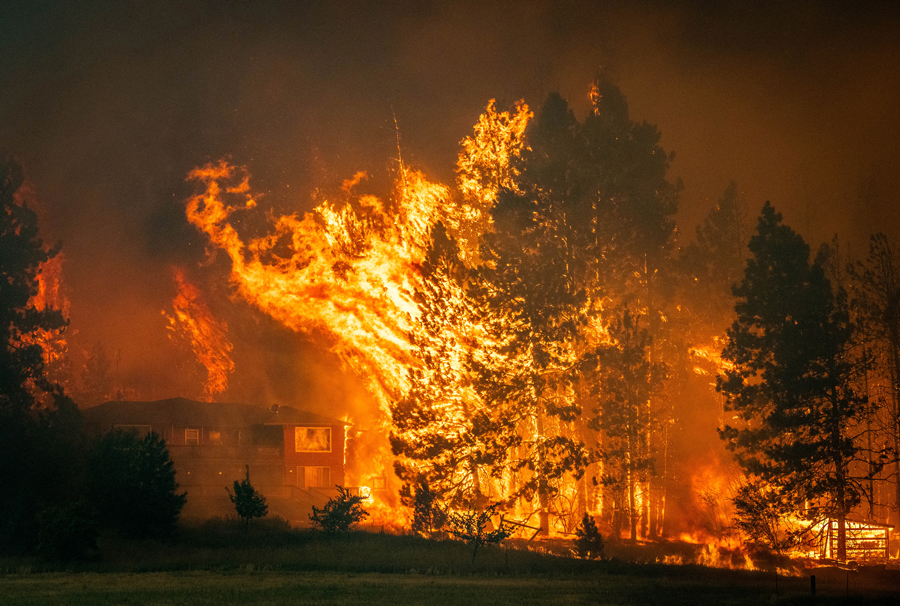
On August 18, 2023, the Gray Fire roared over a ridge along South Medifor Road consuming everything in its path, including this house, ablaze near Medical Lake.
Credit: Courtesy Colin Mulvany/The Spokesman-Review
While the cause of the fire remains under investigation, a prolonged drought combined with over a century of fire suppression, plus a seasonal explosion of grasses and a tinder-dry wildland-urban interface, laid the groundwork. Mayor Terri Cooper describes conditions as a perfect storm for a fire of this magnitude: “7 percent humidity, 25-35 mph winds, and 100-degree temperatures. It was a red flag day.”
By Sunday morning, the Gray Fire had scorched over 10,000 acres across the city and part of unincorporated Spokane County. In all, 244 homes were burned to the ground and one person, 86-year-old rancher Carl Grub, a lifelong resident and a pillar of the community who co-founded Medical Lake’s Jenson Memorial Youth Ranch, was killed. Three months later, a fifth of the population—over 1,000 residents—remained homeless.
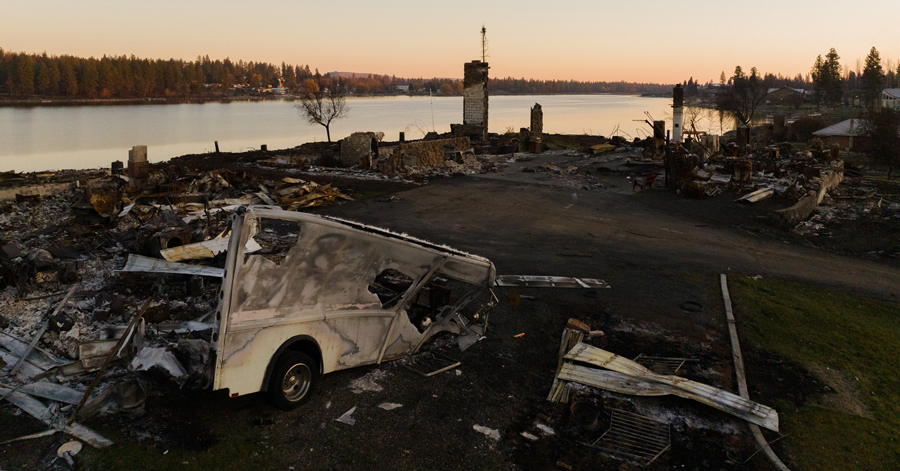
A burned neighborhood on the city’s signature lake.
Credit: Rajah Bose
But the heroic efforts of firefighters—including a helicopter crew that doused the most vulnerable civic structures with water drawn from the city’s namesake lake—spared many more lives and facilities including all municipal buildings, schools, churches, and the area’s two hospitals (Eastern State Hospital, a psychiatric hospital, and Lakeland Village, a state-run care facility for people with intellectual and developmental disabilities).
While the totality of the fire’s impact will be felt well into the future, Mayor Cooper says the actual fire response was impeccable. “The State of Washington has a fantastic incident response system,” she says. “They know who’s in charge, they know where their assets are, and they know who and what they need.” Fire response is jurisdictional, and Medical Lake had recently annexed into Fire District 3, one of the largest districts in the state. “They worked like a well-oiled machine,” Cooper adds.
But what’s frequently missing is a playbook for community recovery, which begins as soon as disaster strikes. Government entities simply aren’t prepared to work as quickly and efficiently as they need to in the wake of a large disaster. “We know we’re responsible for public health and safety, and we need to think intentionally about how to build resiliency after an event like this,” says City Administrator Sonny Weathers. “We simply aren’t prepared for fires of this magnitude.”
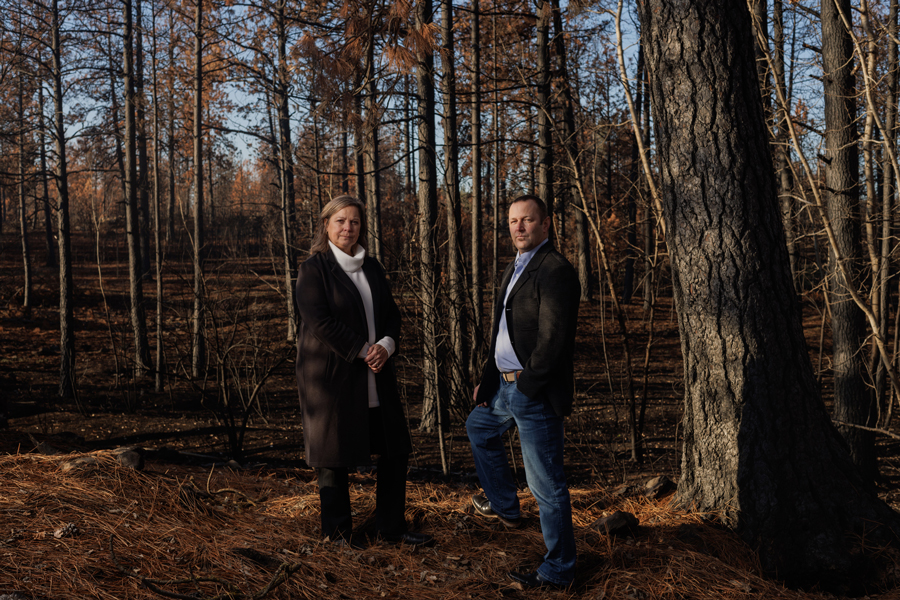
Medical Lake Mayor Terri Cooper and City Administrator Sonny Weathers survey burned timberland on the outskirts of town.
Credit: Rajah Bose
“We know we’re responsible for public health and safety, and we need to think intentionally about how to build resiliency after an event like this. We simply aren’t prepared for fires of this magnitude.”
Medical Lake City Administrator Sonny Weathers
Mayor Cooper is more circumspect. Cleanup is one thing, she notes, but caring for your people is the most important aspect of recovery. “It’s extraordinarily important to have resiliency in government,” she says. “Bringing order to the chaos is our first priority.”
With the fire and aftermath still top-of-mind, Cooper and Weathers are eager to share ideas and advice based on their own experiences. Wildfire is a reality in a warming climate, they say, and lessons learned from one disaster can help deter another by activating a community’s resilience and preparedness.
Mayor Cooper, who took office in January 2022, moved to the area at age 12 when her father took a job at Fairchild Air Force Base. A graduate of Medical Lake High School, she has worked in criminal justice for over 25 years, including 17 years as the City of Cheney’s appointed Municipal Court Administrator/Commissioner. In 2015, Cooper, with a group of Medical Lake local leaders and engaged citizens, formed a nonprofit called Re*Imagine Medical Lake. The organization’s focus, she explains, is to “to rebuild, revitalize, and restore hope in the community” based on a collaborative culture that builds trust and creates meaningful partnerships with government, businesses, schools, nonprofit organizations, and residents. When Cooper realized she could amplify her community impact by assuming a leadership role in local government, she decided to retire early and run for mayor.
Little did she know at the time how integral the nonprofit would be in her community’s post-fire recovery efforts. Re*Imagine Medical Lake has partnered with the city—along with area churches, businesses, and nonprofits—to coordinate the Gray Fire response, including collecting tax-deductible donations for fire victims. “My first advice to any community is this: If you have a nonprofit in your community that’s willing to do the work, and they have the passion—partner with them,” she stresses.
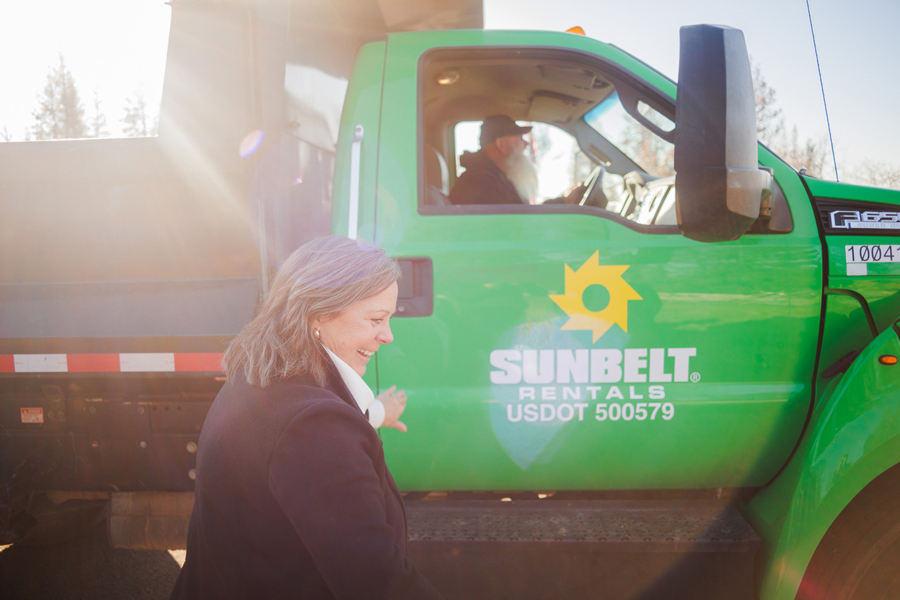
Mayor Cooper and her husband (seated in truck) volunteer with community cleanup efforts following the devasting fire.
Credit: Rajah Bose
“It’s extraordinarily important to have resiliency in government. Bringing order to the chaos is our first priority.”
Medical Lake Mayor Terri Cooper
A community that cares about the well-being of its citizens is a resilient community, adds Weathers. Describing the first public meeting after the fire in the high school gym as standing room only, the city administrator recounts how local leaders who had lost their homes turned to the audience to offer help. “Instead of asking us (the government) what we were going to do for them, they asked what they could do to help those in need,” Weathers recalls, adding that the moment was remarkable in the clarity it provided during a time of fear and chaos. “Staring at the devastation and the mountain of steps it’s going to take to recover, the community’s support for one another was truly astonishing.”
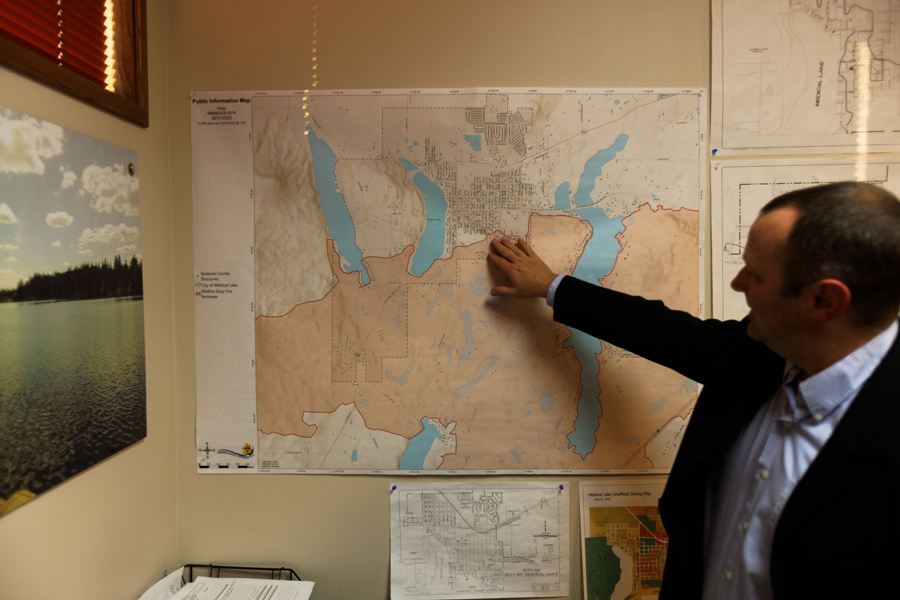
Sonny Weathers with a map illustrating the extent of acreage that was consumed by the Gray Fire.
Credit: Rajah Bose
“Staring at the devastation and the mountain of steps it’s going to take to recover, the community’s support for one another was truly astonishing.”
Sonny Weathers
Equally as important, he adds, was the outpouring of support the community received from peers in local government around the state—including officials who had helped with recovery efforts after the towns of Malden and Pine experienced a similarly devastating wildfire in 2020—relationships established via networking at conferences and trainings offered by organizations like AWC.
“From the moment the fire happened, our friends that AWC had connected us with came from every direction,” Weathers says. “What sticks in my mind is that right after the fire, AWC CEO Deanna Dawson visited and said, ‘We’re here for you. How can we help?’ One of the most important things we recognized through all of this was that having those connections is invaluable … and helps us be ready for whatever comes our way.”
And that is, after all, the essence of resilience.
Wildfire response: Lessons learned from the City of Medical Lake
Create defensible space
Creating defensible space around homes and property to minimize risk is one of the primary goals of Washington state’s Wildland-Urban Interface (WUI) code. A mandatory first step that every community should be considering now—if they haven’t already—is creating and maintaining defensible space via prescribed burns, advises City Administrator Sonny Weathers. “One hundred years of fire suppression means that we have a fuels problem in our forests and now we’re very vulnerable. We think we’re safe because we have avoided a catastrophic fire,” he continues, “but, in fact, the opposite is true.” Adds Mayor Terri Cooper: “All the fuel that was not mitigated prior to the Gray Fire added to how fast and hot it burned.”
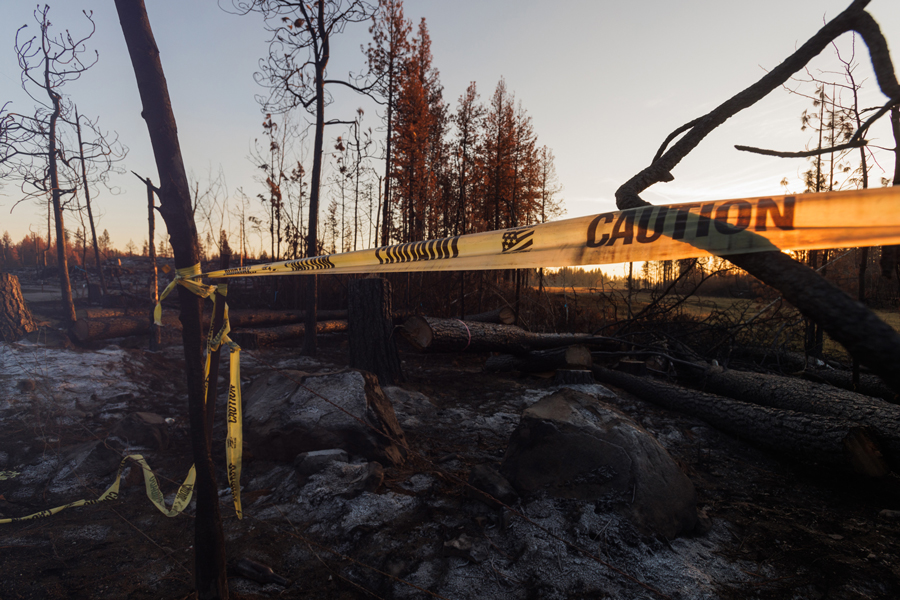
Timberland consumed by the Gray Fire; a century of fire suppression in forests surrounding the city contributed to how fast and hot the wildfire burned.
Credit: Rajah Bose
Plan for evacuation
For local officials in Medical Lake, evacuating an entire city in the face of an unpredictable fire fueled by high winds proved to be cumbersome at best. “Emergency management agencies practice these things,” says Mayor Cooper. “They show up and they know how to organize and protect people in a situation like this. Cities do not.” In the case of the 2023 Gray Fire, the evacuation site had to be moved at least twice during the first several hours due to the fire’s erratic nature. Buses transported the truly vulnerable, while traffic was backed up with others trying to leave as quickly as possible.
Additionally, residents turned on their sprinkler systems with the hope that any available water could help deter the fire. Not surprisingly, the reservoir drained quickly. The Washington Department of Health issued a boil water order for all residents, as the water treatment and pumping operations at city facilities were compromised. “We have a staff of 20 people, and we were all working to cap the water and sewer as quickly as possible while the fire was burning out of control,” recalls Cooper.
Test emergency alerts
The first communication the residents of Medical Lake received in August 2023 was a Level 3 Evacuation Notice. Unlike Levels 1 and 2, which warn residents to be prepared to evacuate, Level 3 is an order: leave within a specified time period, by pre-designated routes. Within two hours of that notice, houses were burning.
Word of the fire and the evacuation notice spread primarily from neighbor to neighbor and via social media, says Cooper, because the city’s emergency notification system did not reach all residents. Separately, in early October, FEMA, in coordination with the FCC, conducted a nationwide test of the Emergency Alert System and Wireless Emergency Alerts to ensure that cell phones, radios, and televisions continued to be effective means of warning the public about emergencies. Municipal governments, Cooper says, need to know how to tap into this system in the event of an emergency.
Plan for environmental damage mitigation in the aftermath of a fire
In addition to substantial structural damage, the Gray Fire exacted a toll on the environment, burning more than 10,000 acres and thousands of trees. Much of the damage occurred in the wildland-urban interface, says Weathers, where 240 homes in a dense neighborhood on the western shore of Silver Lake adjoin forest land.
Because fires that occur in rural and underdeveloped areas—much of which is classified as wildland-urban interface—are considered secondary, there is no mechanism for cleanup. “We need more post-fire recovery regulations for these areas,” notes Weathers, “because it’s simply not reasonable for cleanup to occur on a property-by-property basis. There are tremendous issues related to public health and safety, and the environmental impact from hazardous waste. When you have a toxic burn environment along a lakeshore, you’re potentially affecting the watershed.”
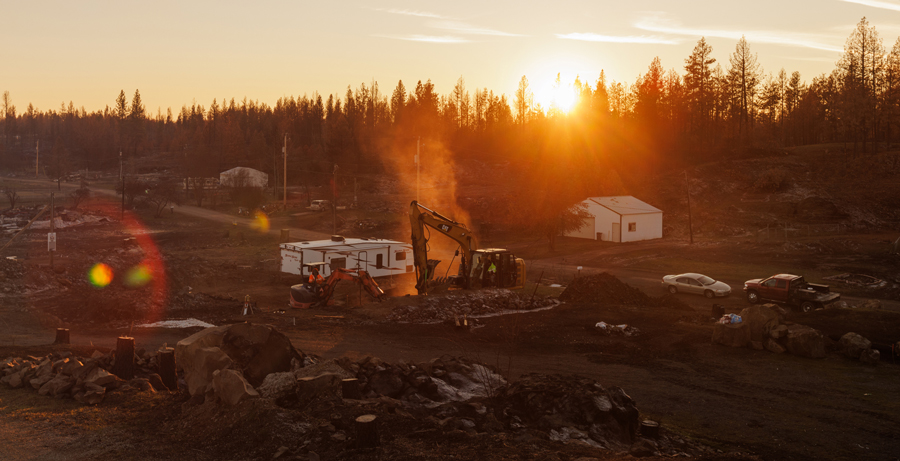
Rebuilding efforts underway in Medical Lake; uninsured property owners who lost homes in the blaze failed to qualify for federal assistance to rebuild.
Credit: Rajah Bose
Don’t count on federal or state financial aid
Because the Gray Fire failed to reach the federal damage threshold of $32 million, the City of Medical Lake was not eligible to receive funding from FEMA. And because the wildfire did not consume enough public infrastructure to meet Washington state’s damage threshold—approximately $13 million—Medical Lake also did not receive state disaster recovery funding either. “It’s disheartening to hear that our personal damage wasn’t enough to warrant assistance from the state,” says Weathers. “It seems so subjective as it applies to our tragedy.” Weathers also notes that since the federal government does not classify wildfires as natural disasters, Medical Lake was unable to receive federal funding for debris clean-up as it might have if it had been hit by an earthquake, tornado, hurricane, or other natural disaster.
The city also explored securing federal funding for uninsured property owners who lost homes in the blaze, but that number (40 homeowners) also fell below the established threshold, says Cooper. Although Governor Jay Inslee released $1.25 million for uninsured property owners in Medical Lake whose homes were destroyed in the Gray Fire, given the average asking price for a home in Medical Lake ($409,000), that number falls far short of the $16.4 million the city’s uninsured homeowners collectively will need to rebuild.
Community partnerships are critical
In the aftermath of the Gray Fire, the city and its community partners have held weekly meetings that started by addressing immediate needs such as debris removal, asbestos testing, and hazard tree removal. These are tangible items that help residents remain hopeful and resilient in the face of the larger unknowns and slow-going nature of federal aid for recovery, says Cooper.
At the same time, she gives high praise to the myriad nonprofit organizations that have come to the aid of Medical Lake in the post-fire landscape. Some, like Re*Imagine Medical Lake, offer assistance through tax-deductible contributions and volunteer cleanup efforts. Others, such as Convoy of Hope, Samaritan’s Purse, and the Red Cross, have stepped in to offer emotional and spiritual support, something she says is vital to the resiliency of every community facing a crisis like this.